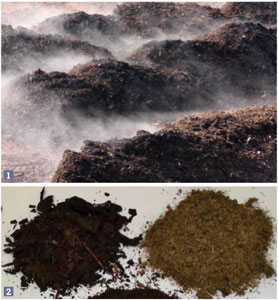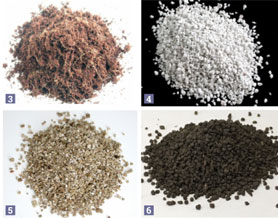6/30/2017
Which Would Work for You?
Ed Bloodnick & Troy Buechel

Formulating a growing medium that works for organic crops can be a challenge depending on the grower’s needs and crop requirements. Organic growing media can include compost, peat, bark and other materials. Some components are acidic and will require pH adjustment with limestone; others are more basic and require little to no limestone. Organic components are typically hard to wet with water and may require a wetting agent.
Some organic growing media may require the addition of an organic starter fertilizer. If it’s added, how long should it last? Which components and starter fertilizers are the best for blending organic growing media and why?
Growing media components
• Concerns with compost: Compost is often used in growing medium, but it presents challenges (Figure 1). Most composts provide varying amounts of beneficial plant nutrients and microorganisms that support proper plant growth. However, compost has fine particles that provide poor physical properties when used in a growing medium. These fine particles plug up air-filled pores in the growing medium, reduce aeration, and thereby, stress plant roots (Table 1).
 Table 1. Common properties of growing media components approved for use in organic growing.
Table 1. Common properties of growing media components approved for use in organic growing.
Watering is critical, as overwatering can quickly make a compost-based growing medium water logged with a very slow dry-down rate. This is especially a problem when starting vegetables or herbs in the winter/early spring when slow drying of the growing medium can increase the potential for root disease. Not to mention there’s greater potential to attract fungus gnats, which feed on rich organic material, such as compost, or shore flies that are looking for wet growing media to reproduce.
 • Figure 1. Compost is often used for organic growing. It provides some plant nutrients, but consists of fine particles that compromise physical properties. • Figure 2. Softwood bark (left) and sphagnum peat moss (right) are consistent growing medium components that work well for organic growing.
• Figure 1. Compost is often used for organic growing. It provides some plant nutrients, but consists of fine particles that compromise physical properties. • Figure 2. Softwood bark (left) and sphagnum peat moss (right) are consistent growing medium components that work well for organic growing.
Another concern with compost is inconsistency. Unless there’s a reliable and reproducible way to produce compost each year, it often has variability that can lead to unpredictable growth or varying availability of nutrients. The feed stock used to make the compost (leaves, grass clippings, food scraps, manures, etc.) must be the same source and amount each time, as each has different nutrient composition, texture, pH and soluble salts.
• Ideal media components: For most growers, eliminating variables is a key to successful growing. Traditional organic materials such as sphagnum peat moss, softwood bark (Figure 2), coir (Figure 3), perlite (Figure 4), vermiculite (Figure 5), expanded clays, etc. have been and continue to be used to create predictable, consistent growing media from year to year.
These materials have consistent and predictable physical properties better suited for growing media because they’re coarser than compost and soil or sand so they can create larger, air-filled pores, reducing potential water logging (Table 1). They work together to allow for faster dry down between waterings, so they’re more forgiving when overwatered, especially during the cloudy winter and early spring months. The chemical properties of these materials are consistent because, unlike compost and coir, they provide few mineral nutrients that can fluctuate, so there are no “hot or cold” pockets of nutrients in the growing medium.
• Biological enhancements: One of the preferred properties of compost is its biological properties. Compost is teeming with various beneficial microorganisms that can convert complex organic molecules into useable plant nutrients. Soilless media formulated with sphagnum peat moss, coir, bark, perlite, etc., have low populations of these microorganisms. Many growing medium companies add biological additives to their organic products to improve biological diversity.
One such biological additive is mycorrhizal fungi, which is a natural fungus that reduces nutritional and water stress of plants. Mycorrhizal fungi colonize plant roots to obtain sugars and other materials from the plant, and in turn, acquire nutrients and water for the plant where its roots aren’t present. Mycorrhizal fungi have been shown to secrete enzymes that aid in the “release” of useable plant nutrients from organic molecules.
Another group of biological additives that are often incorporated into the growing medium are biofungicides. Biofungicides can be natural fungi, bacteria or actinomycetes that colonize plant roots and then suppress root disease pathogens. They reduce plant loss and root disease, making disease management less laborious.
• Figure 3. Coconut coir is us ed in organic growing media due to ease of water absorption. • Figure 4. Perlite reduces water retention, improves drainage and increases aeration. • Figure 5. Vermiculite improves water retention and nutrient retention due to its high cation exchange capacity. • Figure 6. Poultry manure products are often used as a starter fertilizer charge in a certified organic growing medium.
ed in organic growing media due to ease of water absorption. • Figure 4. Perlite reduces water retention, improves drainage and increases aeration. • Figure 5. Vermiculite improves water retention and nutrient retention due to its high cation exchange capacity. • Figure 6. Poultry manure products are often used as a starter fertilizer charge in a certified organic growing medium.
To introduce microorganisms that can help with breakdown of complex organic molecules, the growing medium can be drenched with compost teas. Compost teas provide nearly the same microorganisms found in compost. Also, earthworm castings can be used as a source of inoculating growing media with beneficial microbes. However, the amount used should be kept to a minimum since castings can introduce fine particles.
• pH adjustment: Since sphagnum peat moss and bark are acidic, limestone is typically added to increase the pH of the growing medium. Limestone can be used in certified organic growing and is still the best material for pH adjustment of growing media.
• Wetting agents: Sphagnum peat moss, bark and some composts can be hard to wet with water, especially if they have low moisture content. Traditional growing media have synthetic wetting agents incorporated to help hard-to-wet components absorb water, but they cannot be used for certified organic growing. Yucca-based wetting agents are used, as many are approved for certified organic growing; however, they’re slower to react with water to wet up growing media compared to synthetic wetting agents. Also, since they’re plant derived, microorganisms in the growing medium use them as food, causing rapid degradation of the wetting agent. It’s best to use an organic growing medium within two months (during the warm summer months) to four months (during the cold winter months) after manufacturing to ensure that it properly absorbs water.
Organic starter fertilizer
When it comes to starter fertilizer charges in a certified organic growing medium, most growers prefer having them incorporated into their growing medium. The question is: how long does it need to last? It’s easy to provide a starter fertilizer that can feed vegetable and herb seedlings for up to two weeks for heavy feeders (i.e., peppers, tomato and basil) or three to four weeks for light feeders (i.e., lettuce, greens). Most packaged professional growing media products provide these types of starter fertilizer charges.
• Longevity of starter fertilizer: The starter fertilizer charge in packaged professional growing media comes from one or more of the following sources: animal or poultry manures (Figure 6), soybean meal, alfalfa meal, bone meal, blood meal, seaweed or fish by-products. For light feeders, it’s possible for a starter fertilizer charge to last through most of the crop cycle from seeding to transplanting into the field or garden. However, heavy feeders will require additional fertilizer applications during the production cycle. If there isn’t enough starter fertilizer in a growing medium, should more be added?
Incorporating extra starter fertilizer in the growing medium will increase the electrical conductivity (or soluble salts), which can burn or kill sensitive, light feeders (Figure 2). There can also be large pH fluctuations as nitrogen mineralization and nitrification occur during the first few weeks after producing the growing medium. Also, as Dr. Paul Fisher of the University of Florida reported, high fertilizer levels can burn the roots of young, heavy feeders. This initial root damage can slow plant growth and development, causing a delay in crop timing. However, once the plant recovers, the high fertilizer can then sustain active plant growth. Clearly, adding more starter fertilizer is too risky, as it can cause plant damage.
• Winning combination—short-term starter fertilizer and liquid feeding: The starter fertilizer charge isn’t a “one-rate-fits-all” for all crops. As stated for light feeders, most starter fertilizer charges may provide enough nutrients to sustain a crop in a seed tray or pack through much of the crop cycle. For heavy feeders, liquid fertilizer applications are required to maintain normal plant growth. The most common recommendation found in the literature is applying a constant feed drench with 1 tablespoon fish emulsion per gallon of water. Typically, it should be applied two to three weeks after sowing when much of the starter fertilizer is used up. This rate will vary depending on the analysis of the fish emulsion and stage of plant growth (more mature plants need more fertilizer than seedlings).
In one case, research found that after six weeks, leafy greens used only 15% of the applied nitrogen from a poultry fertilizer. It was believed that the nitrogen was tied up in complex organic molecules and unavailable for plant uptake.
With in-use growing media and plant foliage, it’s always best to monitor crops with lab analysis. Use a reputable lab that has experience in testing growing media and plant tissue for agriculture and horticulture crops. Lab analysis provides a snapshot of the nutrition level of your crops, allowing you to make adjustments during the crop cycle to achieve the best results.
GT
Ed Bloodnick is Director of Grower Services and Troy Buechel is Horticulture Specialist for the Mid-Atlantic in the U.S. for Premier Tech Horticulture.